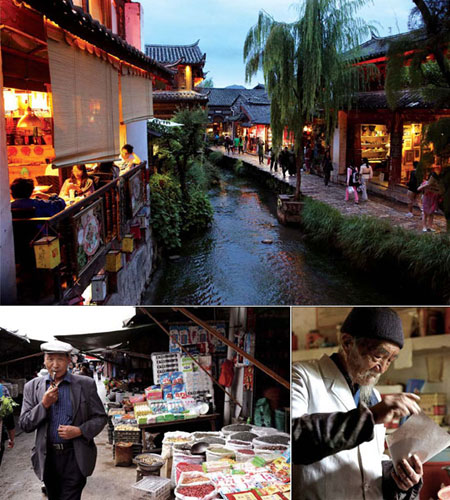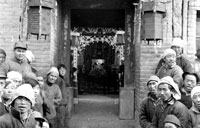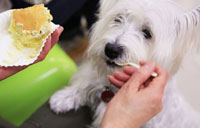36 hours in Lijiang
Updated: 2013-01-04 11:05
By Jeannie Ralston (China Daily)
|
||||||||
 |
|
Clockwise from top: A twilight scene along one of Lijiang Old Town's canals. At 90, Dr Ho Shixiu still runs the Jade Dragon Snow Mountain Chinese Medicine Clinic. An Old Town market offers visitors a glimpse into the local people's life.[ Photos / For Agencies] |
Culture, history, beauty converge in an old city of Yunnan province.
The word "breathtaking" when applied to a Chinese city sometimes refers to respiratory-attack-inducing smog. But in the case of Lijiang, population 1.2 million, in Southwest China's Yunnan province, the word takes on its slack-jaw-in-awe meaning. The horizon here is Himalayan, and the blue sky above the city's stone streets, willow-lined canals and black-tiled roofs is reliably visible. This unusual troika of culture, history and natural beauty is why Lijiang's Old Town - a UNESCO World Heritage Site and a center of the Naxi people - is a top destination for Chinese tourists and a new favorite of the passport-carrying crowd.
Friday, 4 pm
Lijiang was built for commerce about 800 years ago, and a commercial city it remains. Once a crucial trading post on the ancient Tea and Horse Caravan Road connecting Yunnan province and the Tibet autonomous region, it now caters, in large part, to tourists from Beijing and Hong Kong (who apparently really, really like dried yak meat).
The main thing to know about shopping in the pedestrian-only Old Town is that many stores, like those selling hammered silver jewelry and tea bricks, repeat themselves on nearly every street, like the scrolling background in a Tom and Jerry cartoon chase scene.
Browse a few hours through the Mao kitsch (like the canvas "Oba Mao" bags with US President Barack Obama in a Mao suit). You'll find there are many Donga Paper Workshops, a chain that sells paper lampshades and books of locally made paper, but head to the one at Lower Xinyuan Lane, Guangyi Street, where you can make your own sheet in the traditional way. Bunong Bells sells stylized bells (from 160 yuan, or $26) like those worn by horses on the caravan trail.
7 pm
In Square Market, Old Town's main plaza, visitors snake around horsemen trying to attract paying riders. Naxi dance groups bend, clap and spin. To take all this in, rise above it. The second-floor Bells Restaurant and Bar offers a fine selection of New Zealand red wines by the bottle in the 300-yuan range and a view of the action below.
8 pm
In the front window of 88 Snack, a woman slices strips of pea jelly made from black beans. Behind this unassuming facade is the best restaurant in town for Naxi fare. The Dongba spicy chicken lives up to its name, and the roasted eggplant salad is garlic heaven. The adventurous can try deep-fried dragonflies, which taste like especially crunchy seaweed. (Dinner, 110 yuan for two.)
10 pm
The antidote to "Bar Street" (aka Xinhua Street), where nightclubs feature skull-thumping music and where boy bands with high hair dance in spotlights, is Freshnam Cafe, on a quiet strip across town. People come to Freshnam, run by a Korean impresario, Nam Ji-woo, for the simple setting (black bar and small stage), the international beers and the music, which runs toward the folk-rock vein, though with any luck you'll catch a belly-dance number.
 |

 'Taken 2' grabs movie box office crown
'Taken 2' grabs movie box office crown
 Rihanna's 'Diamonds' tops UK pop chart
Rihanna's 'Diamonds' tops UK pop chart
 Fans get look at vintage Rolling Stones
Fans get look at vintage Rolling Stones
 Celebrities attend Power of Women event
Celebrities attend Power of Women event
 Ang Lee breaks 'every rule' to make unlikely new Life of Pi film
Ang Lee breaks 'every rule' to make unlikely new Life of Pi film
 Rihanna almost thrown out of nightclub
Rihanna almost thrown out of nightclub
 'Dark Knight' wins weekend box office
'Dark Knight' wins weekend box office
 'Total Recall' stars gather in Beverly Hills
'Total Recall' stars gather in Beverly Hills
Most Viewed
Editor's Picks

|

|

|

|

|

|
Today's Top News
Boston bombing suspect reported cornered on boat
7.0-magnitude quake hits Sichuan
Cross-talk artist helps to spread the word
'Green' awareness levels drop in Beijing
Palace Museum spruces up
First couple on Time's list of most influential
H7N9 flu transmission studied
Trading channels 'need to broaden'
US Weekly

|

|








